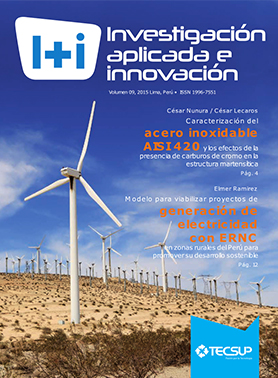Model to Make Electricity Generation Projects Viable by Using NCRE in Rural Areas of Peru to Promote its Sustainable Development
DOI:
https://doi.org/10.71701/8dnbm836Keywords:
Non-Conventional Renewable Energy, Cross impact scenarios, Productive ActivitiesAbstract
This research has for goal to implement a model for developing viable electrical generation projects with use of Non-Conventional Renewable Energy, focused in poor people of rural areas to enable enhance sustainable development. The methodology is based on technique for cross-impact scenarios, applying strategic prospective, as well as non-experimental design without manipulation of variables. The steps for building scenarios include the definition and evaluation of key variables, the identification of the actors, and the analysis of multiple scenarios through the combination of six hypotheses. The model propose the participation of the private sector in the development of energy projects, considering the temporary subsidy of all the levels of government, especially central government; a regulatory framework that encourages the investors’ participation; a financial system supporting the private sector and the active participation of universities, manufacturers and suppliers. For implementing sustainable energy projects it will be necessary a concession granted by the Ministry of Energy and Mines, after fulfil all requirements concerning electricity sector, particularly to add value to its productive use. The research suggests the coordination of projects for productive use, through of the Energy and Mines Ministry or Ministry of Development and Social Inclusion, which they should coordinate areas where energy projects will be concessioned through the evaluation of the use of renewable energy to generate electricity, the social impact on the population and productive activities with sustainable profitability.
Downloads
References
Agencia de Cooperación Internacional de Japón–JICA. (2008). Estudio del Plan Maestro de Electrificación Rural con Energía Renovable en la República del Perú. Lima.
Collado, E. (2009). Energía solar fotovoltaica, competitividad y evaluación económica, comparativa y modelos”. Tesis Doctoral, Escuela Técnica Superior de Ingenieros Industriales- Universidad Nacional de Educación a Distancia. España.
Díaz, P. (2003). Confiabilidad de los sistemas fotovoltaicos autónomos: Aplicación a la electrificación rural. Tesis Doctoral.Universidad Politécnica de Madrid-Escuela Técnica Superior de Ingenieros de Telecomunicaciones, Madrid.
Godet, M. (1993). De la anticipación a la acción. Manual de prospectiva y estrategia, Barcelona, Ed. Marcombo S.A, Barcelona.
Hernández, R.; Fernández, C. & Baptista, P. (2006). Metodología de la investigación 4ta. ed., México: Mc Graw Hill.
Instituto Nacional de Estadística e Informática-INEI. (2013). Informe técnico: Evolución de la pobreza monetaria 2009- 2013. Lima.
Manwell, J.; McGowan, G. & Rogers, A. (2010) Wind Energy Explained: Theory, Design and Application (2da. ed.). Willey, Gran Bretaña.
Perú. Ministerio de Energía y Minas. (2010). Balance Nacional de Energía 2012. Lima: MINAM.
Perú. Ministerio de Energía y Minas. (2010). Propuesta de Política Energética de Estado Perú 2010-2040. Lima:MINAM.
Perú. Ministerio de Energía y Minas. (2013). Plan de Acceso Universal a la Energía 2013-2022. Resolución Ministerial No 203-2013-MEM/DM. Lima: MINAM
REN21: Renewable Energy Policy Network for the 21st Century. (2011). Renewable 2011 Global Status Report. Paris: Worldwatch Institute. pp. (11-25 y 65-70).
Downloads
Published
Issue
Section
License

This work is licensed under a Creative Commons Attribution-NonCommercial 4.0 International License.


